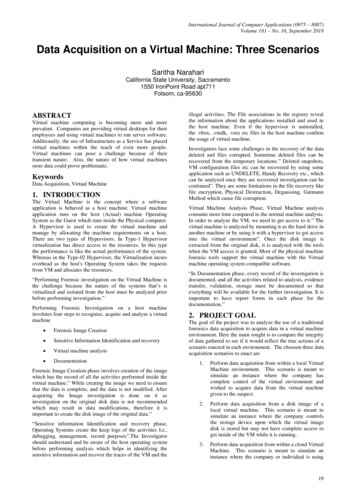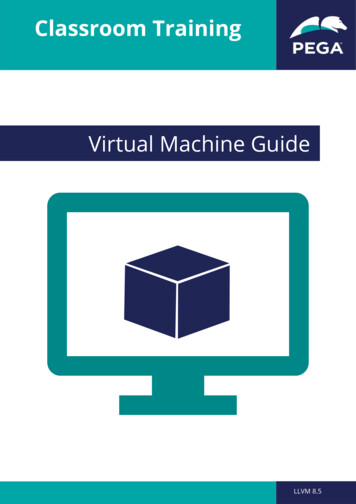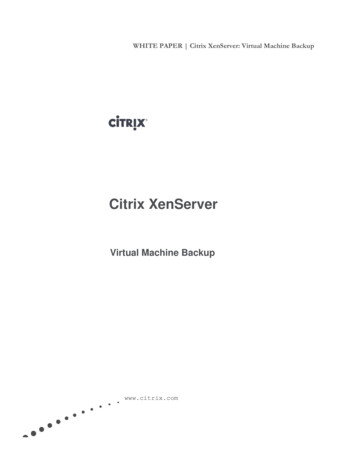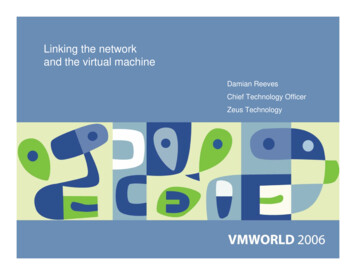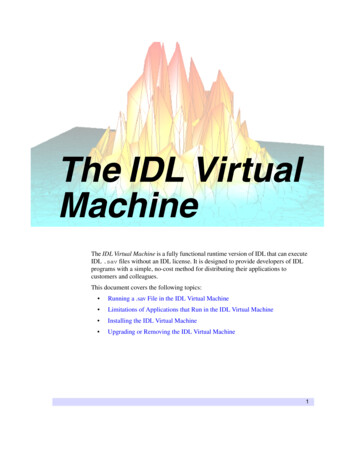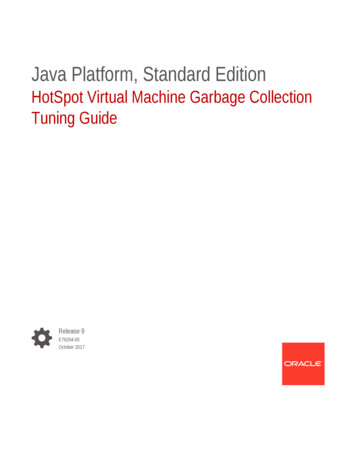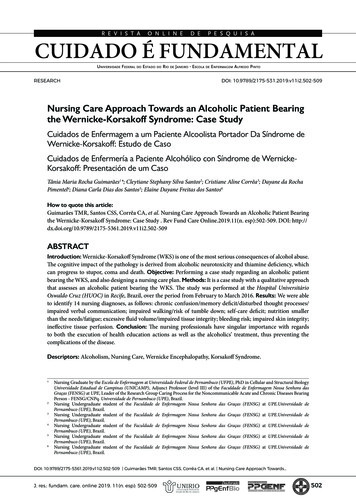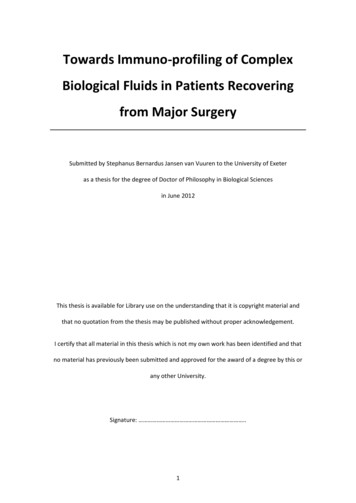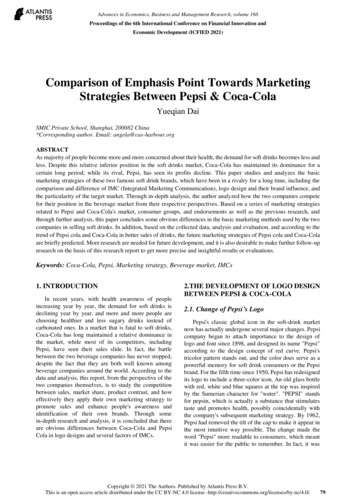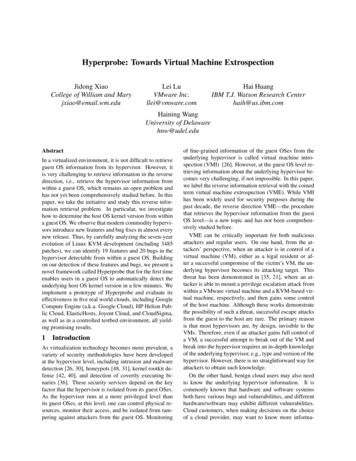
Transcription
Hyperprobe: Towards Virtual Machine ExtrospectionJidong XiaoCollege of William and Maryjxiao@email.wm.eduLei LuVMware Inc.llei@vmware.comHai HuangIBM T.J. Watson Research Centerhaih@us.ibm.comHaining WangUniversity of Delawarehnw@udel.eduAbstractIn a virtualized environment, it is not difficult to retrieveguest OS information from its hypervisor. However, itis very challenging to retrieve information in the reversedirection, i.e., retrieve the hypervisor information fromwithin a guest OS, which remains an open problem andhas not yet been comprehensively studied before. In thispaper, we take the initiative and study this reverse information retrieval problem. In particular, we investigatehow to determine the host OS kernel version from withina guest OS. We observe that modern commodity hypervisors introduce new features and bug fixes in almost everynew release. Thus, by carefully analyzing the seven-yearevolution of Linux KVM development (including 3485patches), we can identify 19 features and 20 bugs in thehypervisor detectable from within a guest OS. Buildingon our detection of these features and bugs, we present anovel framework called Hyperprobe that for the first timeenables users in a guest OS to automatically detect theunderlying host OS kernel version in a few minutes. Weimplement a prototype of Hyperprobe and evaluate itseffectiveness in five real world clouds, including GoogleCompute Engine (a.k.a. Google Cloud), HP Helion Public Cloud, ElasticHosts, Joyent Cloud, and CloudSigma,as well as in a controlled testbed environment, all yielding promising results.1IntroductionAs virtualization technology becomes more prevalent, avariety of security methodologies have been developedat the hypervisor level, including intrusion and malwaredetection [26, 30], honeypots [48, 31], kernel rootkit defense [42, 40], and detection of covertly executing binaries [36]. These security services depend on the keyfactor that the hypervisor is isolated from its guest OSes.As the hypervisor runs at a more privileged level thanits guest OSes, at this level, one can control physical resources, monitor their access, and be isolated from tampering against attackers from the guest OS. Monitoringof fine-grained information of the guest OSes from theunderlying hypervisor is called virtual machine introspection (VMI) [26]. However, at the guest OS level retrieving information about the underlying hypervisor becomes very challenging, if not impossible. In this paper,we label the reverse information retrieval with the coinedterm virtual machine extrospection (VME). While VMIhas been widely used for security purposes during thepast decade, the reverse direction VME—the procedurethat retrieves the hypervisor information from the guestOS level—is a new topic and has not been comprehensively studied before.VME can be critically important for both maliciousattackers and regular users. On one hand, from the attackers’ perspective, when an attacker is in control of avirtual machine (VM), either as a legal resident or after a successful compromise of the victim’s VM, the underlying hypervisor becomes its attacking target. Thisthreat has been demonstrated in [35, 21], where an attacker is able to mount a privilege escalation attack fromwithin a VMware virtual machine and a KVM-based virtual machine, respectively, and then gains some controlof the host machine. Although these works demonstratethe possibility of such a threat, successful escape attacksfrom the guest to the host are rare. The primary reasonis that most hypervisors are, by design, invisible to theVMs. Therefore, even if an attacker gains full control ofa VM, a successful attempt to break out of the VM andbreak into the hypervisor requires an in-depth knowledgeof the underlying hypervisor, e.g., type and version of thehypervisor. However, there is no straightforward way forattackers to obtain such knowledge.On the other hand, benign cloud users may also needto know the underlying hypervisor information. It iscommonly known that hardware and software systemsboth have various bugs and vulnerabilities, and differenthardware/software may exhibit different vulnerabilities.Cloud customers, when making decisions on the choiceof a cloud provider, may want to know more informa-
tion about the underlying hardware or software. This willhelp customers determine whether the underlying hardware/software can be trusted, and thus help them decidewhether or not to use this cloud service. However, forsecurity reasons, cloud providers usually do not releasesuch sensitive information to the public or customers.Whereas research efforts have been made to detect theexistence of a hypervisor [25, 22, 24, 50], from a guestOS, to the best of our knowledge, there is no literature describing how to retrieve more detailed information aboutthe hypervisor, e.g., the kernel version of the host OS, thedistribution of the host OS (Fedora, SuSE, or Ubuntu?),the CPU type, the memory type, or any hardware information. In this paper, we make an attempt to investigatethis problem. More specifically, as a first step towardsVME, we study the problem of detecting/inferring thehost OS kernel version from within a guest OS, and weexpect our work will inspire more attention on miningthe information of a hypervisor. The major research contributions of our work are summarized as follows:sors, and recent hypervisors that take advantage of theseprocessor extensions are called hardware assisted hypervisors [12]. In this paper, we focus on a popular hardware assisted commodity hypervisor, Linux KVM. Wedevelop our framework and perform experiments on aphysical machine with Linux OS as the host, which runsa KVM hypervisor, and a VM is running on top of thehypervisor. Our study covers Linux kernel versions from2.6.20 to 3.14. While 2.6.20, released in February 2007,is the first kernel version that includes KVM, 3.14, released in March 2014, is the latest stable kernel at thetime of this study. More specifically, we study the evolution of KVM over the past seven years and make threemajor observations. In this section, we briefly describeLinux KVM and report our observations.2.1KVM refers to kernel-based virtual machine. SinceLinux kernel version 2.6.20, KVM is merged into theLinux mainline kernel as a couple of kernel modules: anarchitecture independent module called kvm.ko, and anarchitecture dependent module called either kvm-intel.koor kvm-amd.ko. As a hardware assisted virtualizationtechnology, KVM relies heavily on the support of theunderlying CPUs and requires different implementationsfor different CPU vendors, such as Intel VT-x and AMDSVM. Figure 1 illustrates the basic architecture of KVM.KVM works inside a host kernel and turns the host kernelinto a hypervisor. On top of the hypervisor, there can bemultiple VMs. Usually KVM requires a user-level toolcalled Qemu to emulate various devices, and they communicate using predefined ioctl commands.Over the years, KVM has changed significantly. Theoriginal version in 2.6.20 consists of less than 20,000lines of code (LOC); but in the latest 3.14 version, KVMmodules consist of about 50,000 LOC. The reason ofsuch growth is that 3485 KVM related patches have beenreleased by Linux mainline kernel1 . By carefully analyzing these patches, we make a few important observationsabout the evolution of the KVM development process.First, while ideally hypervisors should be transparentto guest OSes, this is not realistic. In particular, during its development process, on the one hand, KVM exposes more and more processor features to a guest OS;on the other hand, KVM has been provided with manyparavirtualization features. These changes improve performance but at the cost of less transparency.Second, for the sake of better resource utilization,KVM has also included several virtualization-specificfeatures, e.g., nested virtualization [16] and kernel same We are the first to study the problem of detecting/inferring the host OS kernel version from withina VM. Exploring the evolution of Linux KVM hypervisors, we analyze various features and bugs introduced in the KVM hypervisor; and then we explain how these features and bugs can be used to detect/infer the hypervisor kernel version. We design and implement a novel, practical, automatic, and extensible framework, called Hyperprobe,for conducting the reverse information retrieval. Hyperprobe can help users in a VM to automatically detect/infer the underlying host OS kernel version inless than five minutes with high accuracy. We perform our experiments in five real worldclouds, including Google Compute Engine [3], HPHelion Public Cloud [29], ElasticHosts [20], JoyentCloud [8], and CloudSigma [19], and our experimental results are very promising. To further validate theaccuracy of Hyperprobe, we perform experiments ina controlled testbed environment. For 11 of the 35kernel versions we studied, Hyperprobe can correctlyinfer the exact version number; for the rest, Hyperprobe can narrow it down to within 2 to 5 versions.2Linux KVMBackgroundHypervisor, also named as virtual machine monitor, is apiece of software that creates and manages VMs. Traditionally, hypervisors such as VMware and Virtual PCuse the technique of binary translation to implement virtualization. Recently, x86 processor vendors includingIntel and AMD released their new architecture extensions to support virtualization. Those hypervisors thatuse binary translation are called software-only hypervi-1 KVM has recently started supporting non-x86 platform, such asARM and PPC; however, in this study, we only consider patches forx86 platforms, i.e., the number 3485 does not include the patches forthe non-x86 platforms.2
Normal UserProcessNormal UserProcessLinux KernelQemuQemuAppAppGuestOSGuestOStranslation, is introduced by Intel since Nehalem processors, and VMCS shadow, which aims to accelerate nestedvirtualization, is introduced since Haswell. Once thesenew hardware features are released, modern hypervisorssuch as KVM and Xen, provide their support for thesenew features on the software side.KVM3Figure 1: KVM OverviewHyperprobe framework has the following goals:page merging (KSM) [15], many of which can be detected from within the guest OS.Third, similar to all other large projects, KVM havebugs. Among the 3485 patches, about 30% of them arebug fixes. In particular, we notice that a common typeof bugs in KVM is related to registers. This reflects thefact that emulating a CPU is hard. Since a modern CPUdefines hundreds of registers, emulating the behaviors ofvarious registers correctly is challenging. Failing to do sousually causes various unexpected results. In fact, register related bugs have been reported on a regular basis.During our study, we discover that these features andbugs can help us determine the underlying hypervisorkernel version. A more detailed description of our design approach is presented in Section 3.2.2Design Practical: The framework should detect the underlying hypervisor kernel version within a reasonableamount of time with high accuracy and precision. Asmore test cases are added to provide more vantagepoints of different kernel versions, its accuracy andprecision should also be improved. Automatic: The framework should run test cases,collect and analyze results automatically withoutmanual intervention. To this end, the test casesshould not crash the guest or host OS.2 Extensible: The framework should be easily extended to detect/infer future Linux kernel versionsand to add more vantage points to previously releasedkernel versions. To this end, the whole frameworkshould be modular, and adding modules to the framework should be easy.3Intel VT-x ExtensionAs a hardware assisted hypervisor, KVM relies on thevirtualization extensions of the underlying processors.In 2006, both Intel (VT-x) and AMD (AMD-SVM) introduced hardware virtualization extensions in their x86processors. According to their respective manuals, thesetwo technologies are very similar to each other. Becauseour current implementation of Hyperprobe is based onthe Intel processors, we will briefly describe Intel VT-x.The key concept of Intel VT-x is that the CPU is splitinto the root mode and the non-root mode. Generally,the hypervisor runs in the root mode and its guests runin the non-root mode. Transitions from the root mode tothe non-root mode are called VM entries, and transitionsfrom the non-root mode to the root mode are called VMexits. The hypervisor can specify which instructions andevents cause VM exits. These VM exits actually allowthe hypervisor to retain control of the underlying physical resources. An example of a VM exit is, when a guestOS attempts to access sensitive registers, such as controlregisters or debug registers, it would cause a VM exit. Ahandler defined by the hypervisor will then be invoked,and the hypervisor will try to emulate the behavior of theregisters. As mentioned above, given the large numberof registers, register emulation is hard and error-prone.The first generation of Intel VT-x processors mainlysimplifies the design of hypervisors. But since then,more and more features have been included in their laterprocessor models. To name a few, Extended Page Table (EPT), which aims to reduce the overhead of address3.1Technical ChallengesTo meet these design goals, we faced several challenges:even though the hypervisor introduces new features frequently, how many of them are detectable from withinthe guest OS? Similarly, how many hypervisor bugs aredetectable from within the guest OS?After manually analyzing the aforementioned 3485patches, we found a sufficient number of features andbugs that meet our requirements. Tables 1 and 2 illustrate the features and bugs we have selected for ourframework. To exploit each, it would require an in-depthknowledge of the kernel and also a good understandingof the particular feature/bug. Due to limited space, weare not able to explain each of the features/bugs, but wewill choose some of the more interesting ones and explain them in the next section as case studies. In thissection, we elaborate on how we use these features andbugs to infer the underlying hypervisor kernel version.3.2KVM FeaturesKVM releases new features regularly. One may infer theunderlying hypervisor kernel version using the following2 Kernel bugs that cause guest or host OS to crash are very common,but we purposely avoided using them in our test cases. One could utilize these bugs to gain more vantage points, but they should be usedwith great caution.3 We plan to make Hyperprobe an open source project so that everyone can contribute, making it more robust and accurate.3
Table 1: Features We Use in Current Implementation of HyperprobeKernel Major .133.14FeaturesDescriptionSupport MSR KVM API MAGICSMP supportExpose KVM CPUID to guestEPT/NPT supportMTRR supportDebug register virtualizationPOPCNT supportKSM supportRDTSCP support, Microsoft EnlightenmentNew kvmclock interfaceSupport MSR KVM ASYNC PF ENAdd ”steal time” guest/host interfaceSupport HV X64 MSR APIC ASSIST PAGEPMU v2 supportSupport MSR KVM PV EOI ENSupport preemption timer for guestNested EPTSupport Nested EPT 2MB pagesSupport HV X64 MSR TIME REF COUNTKVM first merged into Linux mainline kernelCustom MSR register supportSupport multiple processors for guest OSKVM CPUID SIGNATUREExtended/Nested Page TableSupport the memory type range registers for guest OSAdd support for guest debugSupport POPCNT instruction in guest OSKernel Same Page MergingSupport RDTSCP instruction and Microsoft EnlightenmentSupport paravirtualized clock for the guestEnable asynchronous page faults deliveryEnable steal timeSupport for Hyper-V lazy EOI processingExpose a version 2 of Performance Monitor Units to guestSupport End of Interrupt ParavirtualizationSupport preemption timer for guestExpose Nested Extended Page Table to guest OSExpose 2MB EPT page to guestSupport for Hyper-V reference time counterTable 2: Bugs We Use in Current Implementation of HyperprobeFixedBug DescriptionIntro’ed2.6.22MSR IA32 MCG STATUS not writableMSR IA32 EBL CR POWERONnot readableMSR IA32 MCG CTL not readableMSR IA32 PERF STATUSwrong return value upon readMSR IA32 MC0 MISC 20 not readableMSR VM HSAVE PA not readableMSR K7 EVNTSEL0 not readableDR register unchecked accessNo support for clear bit 10 ofmsr register MSR IA32 MC0 CTLNo support for write0x100 to MSR K7 HWCRMSR EBC FREQUENCY ID not readableMSR IA32 BBL CR CTL3 not readableMSR IA32 UCODE REVreturns invalid value upon readWrite 0x8 to MSR K7 HWCR is buggyCPUID returns incorrect valuefor KVM leaf 0x4000000MSR IA32 TSC ADJUST not readableMSR AMD64 BU CFG2 not readableMSR IA32 VMX ENTRY CTLSis not set properly as per specMSR IA32 FEATURE CONTROLbehave weirdlyMSR IA32 APICBASEreserve bit is .123.14version is between 2.6.30 and 2.6.34. However, this maylead to inaccuracies. Since even if feature B is introducedinto the Linux mainline kernel on a particular release,the feature could be disabled by system administrators.Therefore, even if feature B is not detected, it does notmean the underlying hypervisor kernel version is olderthan 2.6.35. Such customizations could impact precision.To avoid such inaccuracies, Hyperprobe uses the following strategy to handle the existence or non-existenceof a kernel feature: if we detect a feature exists, we assert that the underlying hypervisor kernel version is noolder than the version in which this feature was first introduced. By designing test cases that detect these features, we report a minimum version number. This number can be viewed as the lower bound of the underlyinghypervisor kernel 02.6.203.13.12.6.206/2/2014 - 10/2/2014Detect feature A and bug B6/1/201411/1/2014Bug B is fixed in 2.6.35Feature A is introduced in 2.6.306/2/2014 - 10/2/2014Interval Description. 6.1.20142.6.30 7.1.20148.1.20149.1.20142.6.31 2.6.32 2.6.3310.1.20142.6.34 11.1.20142.6.35 12.1.20142.6.36.5.1.201412.30.2014Figure 2: An Inferring Example of The Hyperprobelogic: if feature A is introduced in 2.6.30 and feature Bis introduced in 2.6.35, then if one can detect feature Abut not B, one may infer that the underlying host kernel4KVM Bugs and Bug FixesKVM has bugs and bug fixes like any other software. Ifbugs can be detected from within the guest OS, then onemay infer the underlying hypervisor kernel version using the following logic: assuming bug A is fixed in kernel version 2.6.30, and bug B is fixed in kernel version2.6.35. If one detects that bug A does not exist but bug Bdoes, one may infer that the underlying hypervisor kernelis between 2.6.30 and 2.6.34. Similarly, this may lead toinaccuracies, as a bug could be manually fixed in an olderkernel without updating the entire kernel. Therefore, thenon-existence of a bug does not necessarily mean the kernel is newer than a particular version.To avoid such inaccuracies, Hyperprobe uses the following strategy to handle the existence or non-existenceof a kernel bug: if a bug is detected, we assert that theunderlying kernel version is older than the kernel version where this bug is fixed. By creating test cases thatdetect kernel bugs, we report a maximum version num-
ber. This number can be viewed as the upper bound ofthe underlying hypervisor kernel version. Along with thetest cases that detect kernel features, which can report alower bound, we can then narrow down the hypervisorkernel to a range of versions. Figure 2 illustrates an example: upon the detection of feature A and bug B, wereport that the hypervisor has kernel version 2.6.30 asthe lower bound and 2.6.34 as the upper bound.4Memory Page 1(non shared page)Identical?Memory Page 1(shared
KVM has also included several virtualization-specific features, e.g., nested virtualization [16] and kernel same 1KVM has recently started supporting non-x86 platform, such as ARM and PPC; however, in this study, we only consider patches for x86 platforms, i.e., the number 3485

